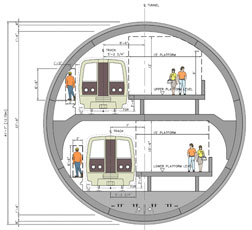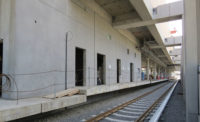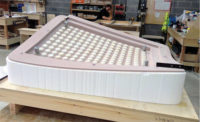| + Enlarge this image |
 |
| Earth pressure balance system has bever been tried in U.S. on a bore this large. (Photo courtesy of Dragados) |
A proposed extension of the Washington, D.C.-area's Metrorail system to Dulles International Airport could be heading underground. A report released July 31 stated that it would be feasible to construct a 0.4-mi large-bore tunnel segment through Tysons Corner, Va., with an 11% higher construction cost and small difference in schedule compared with an elevated rail option.
The report stemmed from a two-month evaluation of engineering options for the Tysons Corner segment. Virginia Secretary of Transportation Pierce Homer asked the American Society of Civil Engineers in May to form the panel to review options.
The panel was not asked to make a recommendation, but Robert O'Neil, chairman of the Dulles Metrorail Tunnel Review Panel, said the tunnel appears to be a favorable option.
"Considering the magnitude and long-term impact of this project, and considering that the intangible benefits almost entirely favor the tunnel, it is reasonable to conclude that our findings suggest strong consideration of the tunnel alternative," said O'Neil, who is a former president and CEO of Parsons Transportation Group Inc.
The panel's report estimated that the project's 11.6-mi. first phase, including the tunnel option, would cost nearly $2.5 billion, compared with $2.25 billion for the aerial plan. The report also stated that construction time for both options would be nearly four years, although up to one additional year would be needed for preliminary engineering of the tunnel section. O¹Neil said he is confident that an additional environmental impact study would not be needed, which could add nearly six months to the schedule. Click here to view the report.
The panel noted several short-term savings under the tunnel option. Tunnel boring would save nearly $30 million for less-permanent utility and temporary construction easements, and as much as $40 million in utility relocation and support costs, it said. A tunnel would have an expected life of approximately 120 years, double the life cycle of an above-ground system. Nearly $5 million in annual savings in operating and maintenance costs could also be realized with the tunnel option, according to the report.
If selected, the tunneling would use an earth pressure balance method to cut a 41.7-ft diameter tunnel. The method has been used in Europe and Asia, but not in the United States on such a large diameter project, O¹Neil said.
O¹Neil said he anticipated the tunnel plan would be well received based on the reactions of a "stakeholder group" that attended panel meetings. That group included representatives of the Federal Transit Administration, the Metropolitan Washington Airports Authority and Fairfax County, Va.
Virginia Governor Tim Kaine is expected to weigh in on the panel¹s findings by the end of August, said Scott Kasprowicz, Virginia's deputy secretary of transportation. In addition to extending the schedule by nearly one year, Kasprowicz confirmed that funding would need to be made final for the more expensive tunnel option.



Post a comment to this article
Report Abusive Comment